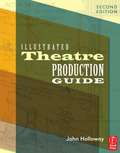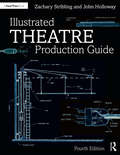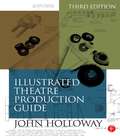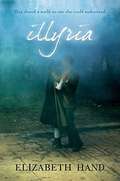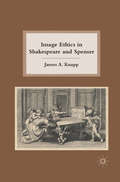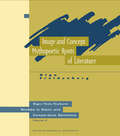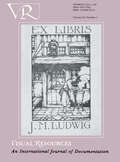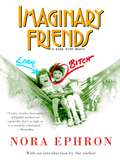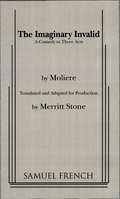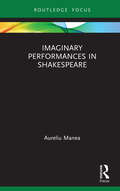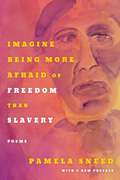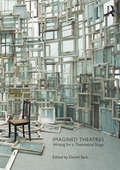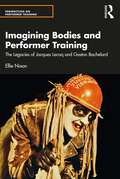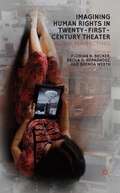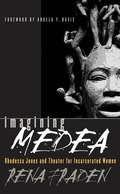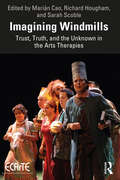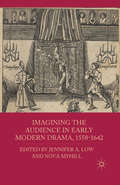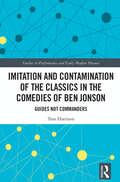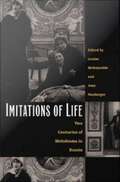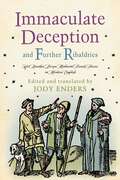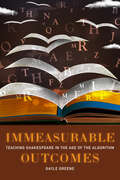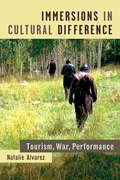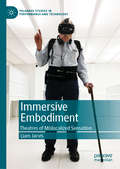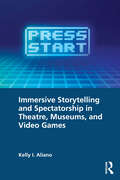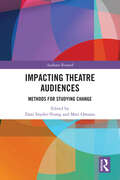- Table View
- List View
Illustrated Theatre Production Guide
by John HollowayThis new and fully updated edition of the Illustrated Theatre Production Guide takes a step-by-step approach to the most common and popular theatre production practices, covering important issues related to the construction of wooden, fabric, plastic, and metal scenery used on the stage. This book examines theatres and their equipment, tools and materials, and scenery construction, as well as the principles of electricity and implementation of a lighting design. New additions include: * Hundreds of unique hand-drawings that illustrate lessons, giving detailed, dimensional instruction * New chapters on stage management and electrical theory as it relates specifically to stage lighting * Completely revamped chapters on metal frame construction and the practice of entertainment lighting covering DMX signals, dimmer mechanics, power distribution, digital lighting * Eco-friendly tips on how to reuse and recycle props and set material * Multiple do-it-yourself projects and practice problems *Companion website with a solutions manual and how-to videos that give an exclusive visual on crucial backstage tasks such as properly tying knots, building a chandelier, and constructing an outdoor stage Illustrated Theatre Production Guide, Second Edition offers techniques and best-practice methods from an experienced industry expert, creating a foundation on which to build a successful and resourceful career behind the scenes in theatre production.
Illustrated Theatre Production Guide
by Zachary Stribling John Ramsey HollowayNow in its fourth edition, Illustrated Theatre Production Guide delivers a step-by-step approach to the most prevalent and established theatre production practices, focusing on essential issues related to the construction of wooden, fabric, plastic, and metal scenery used on the stage. Offering techniques and best-practice methods from experienced industry experts, this book allows readers to create a foundation on which to build a successful and resourceful career behind the scenes in theatre production. The new edition has been fully updated to include the latest technology and current practices, with four new chapters on Safety, Automation, Digital Fabrication, and the Production Process, and an emphasis on inclusivity and gender-neutral language. A must-have resource for both the community theatre worker who must be a jack of all trades and the student who needs to learn the fundamentals on his or her own, Illustrated Theatre Production Guide covers all the necessities of theatre production through detailed lessons and hundreds of drawings. The book also includes access to a companion website featuring instruction videos, tips for an eco-friendly production, and additional images and resources.
Illustrated Theatre Production Guide
by Zachary StriblingIllustrated Theatre Production Guide delivers a step-by-step approach to the most prevalent and established theatreproduction practices, focusing on essential issues related to the construction of wooden, fabric, plastic, and metal scenery used on the stage. A must-have resource for both the community theatre worker who must be a jack of all trades and the student who needs to learn the fundamentals on his or her own, it covers the necessities in great detail, without bogging you down. Offering techniques and best-practice methods from an experienced industry expert, it will allow you to create a foundation on which to build a successful and resourceful career behind the scenes in theatre production. This third edition has been completely restructured to more effectively lead you through the basics of stagecraft. Through detailed lessons and hundreds of drawings, author John Holloway offers you solutions to the problems that you’ll face every day in a production, from rigging to knot tying. New to this edition are guides to jobs in theatre, construction documentation, and video projection methods, with expanded information on Thrust Theatres, lighting, audio and video practices.
Illyria
by Elizabeth HandMadeleine and Rogan are first cousins, best friends, twinned souls, each other’s first love. Even within their large, disorderly family-all descendants of a famous actress-their intensity and passion for theater sets them apart. It makes them a little dangerous. When they are cast in their school’s production of Twelfth Night, they are forced to face their separate talents and futures, and their future together. This masterful short novel, winner of the World Fantasy Award, is magic on paper. .
Image Ethics in Shakespeare and Spenser
by Victoria Katherine BurbankFocusing on works by Shakespeare and Spenser, this study shows the connection between visuality and ethical action in early modern English literature. The book places early modern debates about the value of visual experience into dialogue with subsequent philosophical and ethical efforts.
Image and Concept: Mythopoetic Roots of Literature
by Olga FreidenbergFirst published in 1997. Routledge is an imprint of Taylor & Francis, an informa company.
Images Libraries Museums/Arch
by Amy MccollFirst Published in 1997. Routledge is an imprint of Taylor & Francis, an informa company.
Imaginary Friends: A Play With Music
by Nora EphronAlthough Lillian Hellman and Mary McCarthy probably only met once in their lives, their names will be linked forever in the history of American literary feuds: they were legendary enemies, especially after McCarthy famously announced to the world that every word Hellman wrote was a lie, “including ‘and’ and ‘the. ’” The public battle, and the legal squabbling, that ensued ended, unsatisfactorily for all, with Hellman’s death. InImaginary Friends,Nora Ephron brilliantly and hilariously resuscitates these two bigger-than-life women to give them a post-mortem second act, and the chance to really air their differences. From the Trade Paperback edition.
Imaginary Invalid (Stone)
by MoliereComedy / 8m, 4f / Interior / Monsieur Ardin, the imaginary invalid, is a thoroughgoing hypochondriac. His daughter, Angelique, is in love with Cleante. But Ardin insists that she shall marry the son of a doctor and a doctor himself, Thomas Defois. Toinette, the maid and Beralde, Ardin's brother, do everything possible to dissuade Ardin in his determination to marry Angelique to the stupid Thomas. Beline, Ardin's shrewish wife, is determined that Angelique shall become a nun so that there will be no one but she, Beline, to inherit Ardin's estate. By many tricks, Toinette and Beralde show up Beline as the mercenary she is and the doctors as the fools they are.
Imaginary Performances in Shakespeare
by Aureliu ManeaIn Imaginary Performances in Shakespeare, visionary modernist theatre director Aureliu Manea analyses the theatrical possibilities of Shakespeare. Through nineteen Shakespeare plays, Manea sketches the intellectual parameters, the visual languages, and the emotional worlds of imagined stage interpretations of each; these nineteen short essays are appended by his essay ‘Confessions,’ an autobiographical meditation on the nature of theatre and the role of the director. This captivating book which will be attractive to anyone interested in Shakespeare and modern theatre.
Imagine Being More Afraid of Freedom than Slavery
by Pamela SneedAn incendiary literary work more relevant now than ever.“if anger were an ax/it would split me open/and if this is a sermon/let it be my granddaddy’s sermon/my grandmother’s foottapping/steady rocking/choir singing” —from "It Is Not a New Age"First published in 1998, Imagine Being More Afraid of Freedom than Slavery is the debut collection by acclaimed poet and performer Pamela Sneed. Provocative and potent, it tackles the political and personal issues of enslavement, sexuality, emotional trauma, and abuse. These poems chart the journey of an artist trying to escape cycles of dependency and reclaim lost self and identity. Drawing parallels to Harriet Tubman’s journey on the Underground Railroad, Sneed’s explorations of the woods are a metaphor and emotional path one must explore to attain self-ownership. Sneed’s poems are bound by the search for love, freedom, and justice—from images of lesbian love to Emmet Till’s bloated body, they offer a raging cry and a roadmap for those interested in transforming the personal into social justice and abolitionist practices.
Imagined Theatres: Writing for a Theoretical Stage
by Daniel SackImagined Theatres collects theoretical dramas written by some of the leading scholars and artists of the contemporary stage. These dialogues, prose poems, and microfictions describe imaginary performance events that explore what might be possible and impossible in the theatre. Each scenario is mirrored by a brief accompanying reflection, asking what they might mean for our thinking about the theatre. These many possible worlds circle around questions that include: In what way is writing itself a performance? How do we understand the relationship between real performances that engender imaginary reflections and imaginary conceptions that form the basis for real theatrical productions? Are we not always imagining theatres when we read or even when we sit in the theatre, watching whatever event we imagine we are seeing?
Imagining Bodies and Performer Training: The Legacies of Jacques Lecoq and Gaston Bachelard (Perspectives on Performer Training)
by Ellie NixonThis book is a practical and theoretical exploration of the embodied imagining processes of devised performance in which the human and more-than-human are co-implicated in the creative process.This study brings together the work of French theatre pedagogue Jacques Lecoq (1921–1999) and French philosopher of science and the imagination Gaston Bachelard (1884–1962) to explore the notion of the imagination as embodied, enactive and embedded in the devising process. An exploration of compelling correspondences with Bachelard, whose writings imbue Lecoq’s teaching ethos, offers new practical and theoretical perspectives on Lecoq’s ‘poetic body’ in contemporary devising practices. Interweaving first-hand accounts by the author and interviews with contemporary international creative practitioners who have graduated from or have been deeply influenced by Lecoq, Imagining Bodies in Performer Training interrogates how his teachings have been adapted, developed and extended in various cultural, political and historical settings, in Europe, Scandinavia, Asia, and North and South America.These new and rich insights reveal a teaching approach that resists fixity and instead unfolds, develops and adapts to the diverse cultural and political contexts of its practitioners, teachers and students.
Imagining Human Rights in Twenty-First-Century Theater
by Brenda Werth Florian N. Becker Paola S. Hern�ndezThere is extraordinary diversity, depth, and complexity in the encounter between theatre, performance, and human rights. Through an examination of a rich repertoire of plays and performance practices from and about countries across six continents, the contributors open the way toward understanding the character and significance of this encounter.
Imagining Medea
by Rena FradenThis ain't no Dreamgirls," Rhodessa Jones warns participants in the Medea Project, the theater program for incarcerated women that she founded and directs. Her expectations are grounded in reality, tempered, for example, by the fact that women are the fastest growing population in U.S. prisons. Still, Jones believes that by engaging incarcerated women in the process of developing and staging dramatic works based on their own stories, she can push them toward tapping into their own creativity, confronting the problems that landed them in prison, and taking control of their lives. Rena Fraden chronicles the collaborative process of transforming incarcerated women's stories into productions that incorporate Greek mythology, hip-hop music, dance, and autobiography. She captures a diverse array of voices, including those of Jones and other artists, the sheriff and prison guards, and, most vividly, the women themselves. Through compelling narrative and thoughtful commentary, Fraden investigates the Medea Project's blend of art and activism and considers its limits and possibilities for enacting social change.Rhodessa Jones is co-artistic director of the San Francisco-based performance company Cultural Odyssey and founder of the Medea Project: Theater for Incarcerated Women. An award-winning performer, she has taught at the Yale School of Drama and the New College of California.
Imagining Windmills: Trust, Truth, and the Unknown in the Arts Therapies
by Richard Hougham Sarah Scoble Marián CaoImagining Windmills presents a compilation of scholarly chapters by selected authors of global standing in the arts therapies. This book reflects the theme of the 15th International Conference of the European Consortium for Arts Therapies (ECArTE), held in Alcalá de Henares, Spain, birthplace of Miguel de Cervantes. This innovative work seeks to further understanding of arts therapy education, practice and research and incorporates current thinking from art therapists, dance-movement therapists, dramatherapists and music therapists. Writers from Belgium, Germany, Greece, India, Israel, Italy, The Netherlands, Spain, Sweden, UK and USA combine to give an international voice to the book, which celebrates cultural distinctiveness, while also presenting shared intercultural developments in the professions. This interdisciplinary publication explores questions of the unknown and the imagined, misconception, delusion, truth and trust in the arts therapies. It enquires into ways in which education and the practice of the arts therapies engage with the imagination as a place of multiple realities, which may lead us closer to finding our truth. This book will be of interest and relevance not only to those in the arts therapeutic community, but also to a broad audience including those in related professions – for instance psychology, sociology, the arts, medicine, health and wellbeing and education.
Imagining the Audience in Early Modern Drama, 1558–1642
by Jennifer A. Low Nova MyhillThis essay collection builds on the latest research on the topic of theatre audiences in early modern England. In broad terms, the project answers the question, 'How do we define the relationships between performance and audience?'.
Imitation and Contamination of the Classics in the Comedies of Ben Jonson: Guides Not Commanders (Studies in Performance and Early Modern Drama)
by Tom HarrisonThis book focuses on the influence of classical authors on Ben Jonson’s dramaturgy, with particular emphasis on the Greek and Roman playwrights and satirists. This book illuminates the interdependence of the aspects of Jonson’s creative personality by considering how classical performance elements including the Aristophanic ‘Great Idea,’ chorus, Terentian/Plautine performative strategies, and ‘performative’ elements from literary satire manifest themselves in the structuring and staging of his plays. This fascinating exploration contributes to the ‘performative turn’ in early modern studies by reframing Jonson’s classicism as essential to his dramaturgy as well as his erudition. This book is also a case study for how the early modern education system’s emphasis on imitative-contaminative practices prepared its students, many of whom became professional playwrights, for writing for a theatre that had a similar emphasis on the recycling and recombining performative tropes and structures.
Imitations of Life: Two Centuries of Melodrama in Russia
by Louise Mcreynolds Joan NeubergerImitations of Life views Russian melodrama from the eighteenth century to today as an unexpectedly hospitable forum for considering social issues. The contributors follow the evolution of the genre through a variety of cultural practices and changing political scenarios. They argue that Russian audiences have found a particular type of comfort in this mode of entertainment that invites them to respond emotionally rather than politically to social turmoil. Drawing on a wide variety of sources, including plays, lachrymose novels, popular movies, and even highly publicized funerals and political trials, the essays in Imitations of Life argue that melodrama has consistently offered models of behavior for times of transition, and that contemporary televised versions of melodrama continue to help Russians cope with national events that they understand implicitly but are not yet able to articulate. In contrast to previous studies, this collection argues for a reading that takes into account the subtle but pointed challenges to national politics and to gender and class hierarchies made in melodramatic works from both the nineteenth and twentieth centuries. Collectively, the contributors shift and cross borders, illustrating how the cultural dismissal of melodrama as fundamentally escapist and targeted primarily at the politically disenfranchised has subverted the drama's own intrinsically subversive virtues. Imitations of Life will interest students and scholars of contemporary Russia, and Russian history, literature, and theater. Contributors. Otto Boele, Julie Buckler, Julie Cassiday, Susan Costanzo, Helena Goscilo, Beth Holmgren, Lars Lih, Louise McReynolds, Joan Neuberger, Alexander Prokhorov, Richard Stites
Immaculate Deception and Further Ribaldries: Yet Another Dozen Medieval French Farces in Modern English (The Middle Ages Series)
by Jody EndersDid you hear the one about the Mother Superior who was so busy casting the first stone that she got caught in flagrante delicto with her lover? What about the drunk with a Savior complex who was fool enough to believe himself to be the Second Coming? And that's nothing compared to what happens when comedy gets its grubby paws on the confessional. Enter fifteenth- and sixteenth-century French farce, the "bestseller" of a world that stands to tell us a lot about the enduring influence of a Shakespeare or a Molière. It's the sacrilegious world of Immaculate Deception, the third volume in a series of stage-friendly translations from the Middle French. Brought to you through the wonders of Open Access, these twelve engagingly funny satires target religious hypocrisy in that in-your-face way that only true slapstick can muster. There is literally nothing sacred.Why this repertoire and why now? The current political climate has had dire consequences for the pleasures of satire at a cultural moment when we have never needed it more. It turns out that the proverbial Dark Ages had a lighter side; and France's over 200 rollicking, frolicking, singing, and dancing comedies—more extant than in any other vernacular—have waited long enough for their moment in the spotlight. They are seriously funny: funny enough to reclaim their place in cultural history, and serious enough to participate in the larger conversation about what it means to be a social influencer, then and now. Rather than relegate medieval texts to the dustbin of history, an unabashedly feminist translation can reframe and reject the sexism of bygone days by doing what theater always invites us to do: interpret, inflect, and adapt.
Immeasurable Outcomes: Teaching Shakespeare in the Age of the Algorithm
by Gayle GreeneWhat is the purpose of education? The answer might be found in a Shakespeare class at a small liberal arts college.In this engaging account of teaching a Shakespeare class at a small liberal arts college, Gayle Greene illustrates what is so vital and urgent about the humanities. Follow along with Greene as she introduces us to her students and showcases their strengths, needs, and vulnerabilities, so we can experience the magic of her classroom. In Immeasurable Outcomes, Greene's class builds a complex human ecosystem that pushes students to think more deeply and discover their own interests and potential, all while recognizing the inherent dignity in other people's views and values. Grounding her analyses in half a century of teaching, Greene pushes back against the demand for measurable student learning outcomes and the standardization imposed on K-12 schools in the name of reform. Instead, she draws her conclusions about education directly from the students themselves. Alumni testimonials describe the transformative power of a liberal arts education, recounting how their experience of community and engagement has provided them the tools to navigate the uncertainties of a rapidly changing world while also inspiring the social awareness our democracy depends on. Immeasurable Outcomes rejects claims that the liberal arts are impractical, exposing the political agendas of technocrats and ideologues who would transform higher education into vocational training and programs focused only on profitability. Greene reminds us that the liberal arts have been the basis for the most successful educational system in the world and provides a powerful demonstration that education at a human scale that is relationship-rich and humanities-based should be the model for education in the future.
Immersions in Cultural Difference: Tourism, War, Performance
by Natalie AlvarezIn a time of intensifying xenophobia and anti-immigration measures, this book examines the impulse to acquire a deeper understanding of cultural others. Immersions in Cultural Difference takes readers into the heart of immersive simulations, including a simulated terrorist training camp in Utah; mock Afghan villages at military bases in Canada and the UK; a fictional Mexico-US border run in Hidalgo, Mexico; and an immersive tour for settlers at a First Nations reserve in Manitoba, Canada. Natalie Alvarez positions the phenomenon of immersive simulations within intersecting cultural formations: a neoliberal capitalist interest in the so-called “experience economy” that operates alongside histories of colonization and a heightened state of xenophobia produced by War on Terror discourse. The author queries the ethical stakes of these encounters, including her own in relation to the field research she undertakes. As the book moves from site to site, the reader discovers how these immersions function as intercultural rehearsal theaters that serve a diverse set of strategies and pedagogical purposes: they become a “force multiplier” within military strategy, a transgressive form of dark tourism, an activist strategy, and a global, profit-generating practice for a neoliberal capitalist marketplace.
Immersive Embodiment: Theatres of Mislocalized Sensation (Palgrave Studies in Performance and Technology)
by Liam JarvisThis book offers a wide-ranging examination of acts of ‘virtual embodiment’ in performance/gaming/applied contexts that abstract an immersant’s sense of physical selfhood by instating a virtual body, body-part or computer-generated avatar. Emergent ‘immersive’ practices in an increasingly expanding and cross-disciplinary field are coinciding with a wealth of new scientific knowledge in body-ownership and self-attribution. A growing understanding of the way a body constructs its sense of selfhood is intersecting with the historically persistent desire to make an onto-relational link between the body that ‘knows’ an experience and bodies that cannot know without occupying their unique point of view. The author argues that the desire to empathize with another’s ineffable bodily experiences is finding new expression in contexts of particular urgency. For example, patients wishing to communicate their complex physical experiences to their extended networks of support in healthcare, or communities placing policymakers ‘inside’ vulnerable, marginalized or disenfranchised virtual bodies in an attempt to prompt personal change. This book is intended for students, academics and practitioner-researchers studying or working in the related fields of immersive theatre/art-making, arts-science and VR in applied performance practices.
Immersive Storytelling and Spectatorship in Theatre, Museums, and Video Games
by Kelly I. AlianoImmersive Storytelling and Spectatorship in Theatre, Museums, and Video Games is the first volume to explore immersion as it is experienced in all three of these storytelling forms: the theatre, museums and historic sites, and video games. It theorizes what it means for a work to be called immersive and how immersion impacts audience experience in each of these modes.The presentation of story is deepened when it involves the spectator in an immersive way. Author Kelly I. Aliano concentrates on the central idea that the use of immersion in each medium allows the story being told to feel present for the spectator. It puts them at the center of the experience, making its events for and about them. Throughout, the book discusses how immersion is employed to make narrative feel more resonant and relevant for the audience. Analyzing the impact of offering a first-hand experience of story events, this book looks at how immersive storytelling can highlight the ways in which we can interact with and shape our understandings of ourselves and our society as well as our histories and identities.Ideal for students, scholars, and researchers of immersive theatre, spectatorship, museum studies, and video game studies, this is an innovative study into the power of immersive storytelling across three interactive mediums.
Impacting Theatre Audiences: Methods for Studying Change (Audience Research)
by Dani Snyder-Young Matt OmastaThis edited collection explores methods for conducting critical empirical research examining the potential impacts of theatrical events on audience members. Dani Snyder-Young and Matt Omasta present an overview of the burgeoning subfield of audience studies in theatre and performance studies, followed by an introduction to the wide range of ways scholars can study the experiences of spectators. Consisting of chapter length case studies, the book addresses methodologies for examining spectatorship, including qualitative, quantitative, historical/historiographic, arts-based, participatory, and mixed methods approaches. This volume will be of great interest to theatre and performance studies scholars as well as industry professionals working in marketing, audience development and community engagement.
